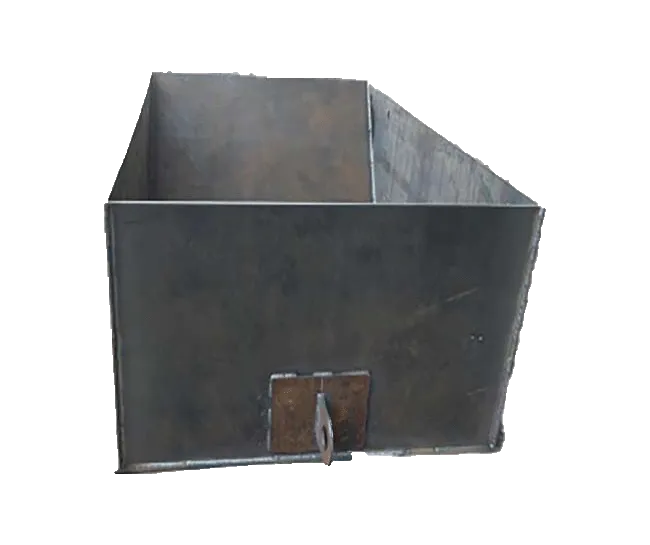Products Description
Waste Hopper: A Practical Equipment for Efficient Collection and Transportation of Waste
In scenarios such as industrial production, construction, and manufacturing processing, the temporary storage and centralized transportation of waste are important links to maintain a clean working environment and improve production efficiency. Waste hoppers, as container equipment specially designed for waste treatment, with the characteristics of large capacity, wear resistance, and easy transportation, have become key tools connecting waste generation and final treatment, playing an irreplaceable role in reducing manual labor and standardizing waste management.
I. Material Selection: Durability Guarantee for Adapting to Various Wastes
The material of the waste hopper should be selected according to the nature of the waste it contains (such as weight, corrosiveness, and sharpness). Common types include:
- High-strength steel plates: Such as Q235 and Q355 low-alloy steel plates. After welding, they have high structural strength and wear resistance, suitable for loading heavy or sharp wastes such as metal chips, construction waste, and stones. They can withstand long-term impact and friction without being easily deformed;
- Stainless steel plates: Mainly 304 stainless steel, which has excellent corrosion resistance. It is suitable for storing industrial wastes with oil stains and chemical residues (such as waste coolant mixed with chips in mechanical processing) or waste materials in the food processing industry. It is also easy to clean to avoid residual stains from breeding bacteria;
- Plastic materials: Such as high-density polyethylene (HDPE), which is lightweight, acid and alkali resistant, and does not react chemically with waste. It is mostly used for loading light waste (such as plastic scraps, paper scraps, textile waste), especially suitable for light industry scenarios with high cleanliness requirements.
Some waste hoppers will be thickened at key parts (such as the bottom and corners) or equipped with wear-resistant liners to further extend their service life.
II. Structural Design: Functional Considerations for Both Storage and Transportation
The structural design of the waste hopper revolves around the two core needs of "efficient loading" and "convenient transportation", mainly including the following parts:
- Hopper body: It is open or semi-closed. The open design is convenient for manual or mechanical direct feeding, while the semi-closed type has an openable top cover to prevent light waste (such as dust and paper scraps) from scattering during transportation; the side of the hopper body is mostly designed in a slope shape to reduce dead corners of waste accumulation and facilitate emptying during unloading;
- Bottom structure: Usually adopts a flat bottom or a design with a discharge port. The flat-bottomed waste hopper has strong stability and is suitable for being fixed beside the work station to store waste; the model with a discharge port is equipped with a manual or pneumatic gate, which can realize rapid unloading by controlling the opening and closing of the gate without tilting the hopper body;
- Hoisting and moving parts: Large industrial waste hoppers will be welded with lifting rings or hooks on the top, which are compatible with cranes, forklifts and other equipment for transportation; small waste hoppers may be installed with universal wheels at the bottom, which is convenient for manual pushing and flexibly adapts to the moving needs of different working areas;
- Reinforcing structure: Reinforcing ribs will be welded at the joints of the edge, bottom and side of the hopper body to improve the overall rigidity and prevent deformation due to excessive gravity after being filled with waste.
III. Core Uses: A Key Role Throughout the Entire Waste Treatment Process
The core function of the waste hopper is to realize the efficient transfer of waste from the point of generation to the centralized treatment point. The specific applications are reflected in:
- Temporary storage: Placed beside the production line and near the construction work station, it collects waste generated during work at any time (such as metal chips from machine tool processing, broken bricks and cement from construction, waste cartons from the packaging industry), avoiding waste scattering and polluting the environment, and keeping the working area clean;
- Centralized transportation: When the waste hopper is full, it is transported to the waste storage area, recycling station or processing equipment (such as crushers, balers) by forklifts, cranes and other equipment, reducing the labor intensity of manual handling, especially suitable for the transportation of heavy or bulk waste;
- Classified collection: Through waste hoppers of different colors or signs, recyclable waste (such as waste iron, waste paper) and non-recyclable waste can be collected separately, providing convenience for subsequent resource recycling;
- Safety protection: For waste with sharp edges, corrosiveness or toxicity, special waste hoppers (such as sealed stainless steel hoppers) can avoid direct contact of waste with the human body or the environment, reducing potential safety hazards.
From factory workshops to construction sites, from garbage disposal stations to logistics warehouses, waste hoppers are the basic equipment for maintaining orderly waste management.
IV. Types and Adaptable Scenarios
According to the usage scenarios and functional requirements, waste hoppers can be divided into multiple types:
- Fixed waste hoppers: Large in size, without moving parts, fixedly installed in areas where waste is generated centrally (such as the end of the machine tool production line), and fed through pipelines or conveyors, suitable for large-scale and continuous production waste collection;
- Mobile waste hoppers: With wheels at the bottom or hoisting structures on the top, they are highly flexible and suitable for small and medium-sized workplaces (such as decoration sites, small processing plants), and can be flexibly moved according to the location where waste is generated;
- Self-unloading waste hoppers: Equipped with hydraulic or mechanically driven unloading devices, they can complete unloading without relying on external equipment, and are often used in construction waste removal, industrial waste centralized treatment and other scenarios to improve unloading efficiency;
- Special waste hoppers: Such as leak-proof waste hoppers (for storing liquid waste or waste containing moisture) and explosion-proof waste hoppers (for flammable and explosive waste), designed according to the characteristics of special waste to ensure safe and compliant treatment processes.
V. Usage Advantages and Maintenance Points
Waste hoppers show multiple advantages in practical applications:
- Improve efficiency: Replace traditional simple containers such as sacks and baskets, with a larger single storage capacity, reducing the number of transports; combined with mechanical transportation, greatly reducing labor costs;
- Protect the environment: Avoid environmental pollution caused by scattered waste, and facilitate subsequent cleaning and environmental protection treatment;
- Extend equipment life: Reduce the wear of production equipment caused by waste accumulation (such as metal chips entering the machine tool guide rail), and indirectly improve the service life of production equipment.
In daily use, the following maintenance matters should be noted:
- Regularly clean the residual waste in the hopper body to prevent corrosive substances from adhering for a long time and causing material damage;
- Check the wear of lifting parts, wheels, gates and other moving structures, and timely lubricate or replace vulnerable parts;
- For metal waste hoppers, regularly paint anti-rust paint to prevent rust from affecting structural strength.
Summary
Although the waste hopper seems to be a simple "container", with its targeted material selection and structural design, it has become an "efficiency leader" in the waste treatment process. It organically connects the links of scattered waste collection, concentration, and transportation, not only ensuring the cleanliness of the working environment but also reducing the intensity of manual labor, providing basic support for the standardization and efficiency of industrial production and engineering construction. In today's era of advocating green production and resource recycling, high-quality waste hoppers are an important link connecting production and environmental protection, helping enterprises achieve sustainable development.



